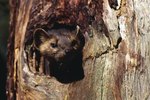
Skunks are a type of mammal found in most parts of the United States. Skunks live in habitats such as grasslands, farmlands, forests and urban settings. The most common species of skunk is the striped skunk (Mephitis mephitis). These critters possess several unique behaviors.
Burrowing Behaviors
Skunks commonly take up residence in abandoned burrows made by other animals like foxes, especially in the wintertime when they are caring for their offspring, or kits. To keep warm, they stuff the tunnels and nesting areas with dried leaves, which provide the mammals with insulation. Although they don't actually hibernate, skunks that live in colder habitats do experience a dormancy period, where they live off their fat reserves while hiding in their warm burrows. During the summer, skunks live in hollowed-out logs, beneath barns and sheds, and in wood piles.
Mother Knows Best
Skunks are solitary mammals, typically only coming together with the opposite sex in early spring to mate. They may also socialize with other skunks to share burrows in the winter to keep warm. When ready to mate, males travel long distances to search for mature females. A male will mate with several females, who then carry their young for up to 77 days. A litter of two to ten kits is born in the summer. A male provides no care to his offspring, and if he tries to approach a female and her offspring, he will be faced with a very aggressive mother. By the following spring, the kits will be sexually mature and able to produce offspring of their own. Females reproduce only once per year.
On the Menu
Skunks are twilight or nocturnal feeders. They are opportunistic omnivores, feeding on both animal and plant matter. Their diets change as prey availability fluctuates with each season. During warmer months, skunks feed on insects such as crickets, bees, grasshoppers and grubs. They also feed on worms and crayfish. In the winter, skunks feed on berries, bird eggs and rodents such as voles. To search for their prey, skunks depend on their excellent senses of hearing, smell and vision.
Offensive Defenses
Both male and female skunks are notorious for the stench, or musk, they emit when frightened. This scent is a fluid spray released by the skunk's anal glands. When approached by a potential predator or taken by surprise, a skunk raises its tail and stomps its feet as a warning for the predator to back off. What comes next is a series of five or six putrid sprays, capable of traveling distances up to 20 feet. If sprayed at a close enough distance, the musk can be irritating to the eyes and cause nausea. Although they may not be the first choice meal for most predators, owls and eagles are known to tolerate the musk and hunt for skunks.
References
Photo Credits
-
Tom Brakefield/Stockbyte/Getty Images
Writer Bio
Amanda Williams has been writing since 2009 on various writing websites and blogging since 2003. She enjoys writing about health, medicine, education and home and garden topics. Williams earned a Bachelor of Science in biology at East Stroudsburg University in May 2013. Williams is also a certified emergency medical technician.



